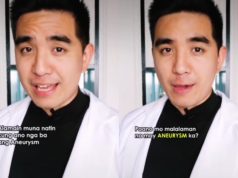
“Hindi po ‘kawawa’ ang kumain mag-isa sa restaurant.”
This was what content creator and physician Winston Tiwaquen, also known as Dr. Kilimanguru, said on Facebook in response to a viral post showing a young man eating alone in a fast food chain.
The talks about “eating alone” started when lifestyle blogger Rod Magaru shared a screengrab of a TikTok clip from an unidentified user who captured someone allegedly eating at a fast food chain in Quezon City.
The clip included a text from the user which reads: “Napansin ko lang si Kuya while kumakain kami sa may QC [Mcdo], wala kasi siyang kasama. I would have liked to sit next to him so he could be with him. Kaso nahiya ako.”
Magaru aired his view about the TikTok post on his Twitter account.
“If I eat alone and you disturb me [in] my own happy place just because your personal take on eating alone is sad, susuntukin kita LOL,” he tweeted.
Magaru’s post has gained a whopping number of 58,100 likes, 14,300 retweets and over 5,000 quote tweets so far.
If I eat alone and you disturb me on my own happy place just because your personal take on eating alone is sad, susuntukin kita LOL. 🎻🎻🎻 pic.twitter.com/MIIBwoVdxu
— Rod Magaru (@rodmagaru) September 4, 2022
The TikTok post opened discussions about people’s preferences when it comes to eating in public places.
Dr. Kilimanguru joined in the conversation and stressed that eating alone in restaurants is normal.
“Hindi po ‘kawawa’ ang kumain mag-isa sa restaurant. Ginagawa ko rin ‘yan and usually it is because I want peace with myself. Ayoko lang talaga ng kausap. It’s a good exercise for your mental health to eat alone at a restaurant. Happy Sunday!”
His Facebook post also gained traction, garnering 119,000 likes and reactions and almost 10,000 shares.
Nurse Even, another content creator, agreed with Dr. Kilimanguru in the comments section.
“True, Doc. Hilig ko din kumain mag isa dati sa Mang Inasal at Chickboy. Pero parang magkasama na din kami nung crew kaka hingi ko ng extra rice,” he commented in jest with upside-down face emojis.
Social media artist Meiko Montefalco, also known as “Master Meiko” on TikTok, also shared her two cents on the matter.
“We have nothing against the content creator, ‘yung nag-take ng video kay kuya, kasi baka mamaya sanay siya na lagi siyang may kasama whenever he or she goes. Kumain siya, may kasama. ‘Pag lumabas siya, may kasama siya. So baka hindi siya sanay makakita ng isang tao na mag-isa na kumakain,” she said on a video.
“But I just want to give everyone an assurance na ganoon. For example, tulad ng content creator na hindi kayo sanay makakita ng mga tao na mag-isa, please, I’m giving you an assurance na okay lang ‘yon,” Meiko added.
“It does not necessarily mean na malungkot sila or wala sa kanilang sumasama. Meron kasing mga tao na vina-value talaga ‘yung alone time nila. Meron silang ‘me time.’ Kasi doon sila nakakakuha ng peace of mind, ganoon. Parang break from other people, from outside world,” she continued.
@mastermeiko #stitch with @dzshoraym_ ♬ original sound – Meiko Montefalco
Similar to her fellow content creators, Meiko’s post also gained traction, earning 473,800 views and 34,400 heart reactions on TikTok.
On dining and solitude
Eating alone in public has earned such a negative perception that people have a term for it — solomangarephobia or the fear of dining by yourself publicly.
Neurobiologist Stephanie Cacioppo said that when it comes to such matters, the “real question is how you feel when you eat.”
For psychologist Sherrie Bourg Carter, spending time alone can be beneficial.
“Constantly being ‘on’ doesn’t give your brain a chance to rest and replenish itself. Being by yourself with no distractions gives you the chance to clear your mind, focus, and think more clearly. It’s an opportunity to revitalize your mind and body at the same time,” she said in Psychology Today.
Carter added that solitude allows people to “discover” themselves and find their own voice.
“When you’re part of a group, you’re more likely to go along with what the group is doing or thinking, which aren’t always the actions you would take or the decisions you would make if you were on your own,” she said.









